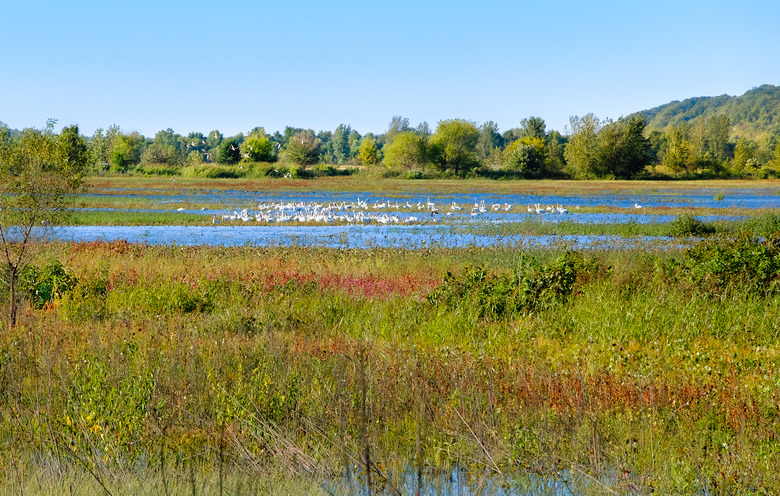Plants & Animals That Lewis & Clark Discovered In The Louisiana Purchase
The Louisiana Purchase of 1803 was a deal made between the United States and France. For 15 million dollars, the United States purchased about 870,000 square miles of land west of the Mississippi River. With all of this new and "undiscovered" land to explore, President Thomas Jefferson employed Meriwether Lewis and William Clark to explore the new American lands.
The animals and plants found in the Louisiana purchase were extensive. Lewis and Clark were some of the first to document whatever flora and fauna they came across. While the types of animals and plants Lewis and Clark discovered were by no means discovered by them (since native people had been living on those lands for hundreds of years), they're often lauded as the first to extensively document and describe these organisms for the world's understanding.
The pair recorded 178 plant species and specimens and 122 animal species that were virtually unknown to the Europeans before coming to America.
Plants Lewis and Clark Discovered
Plants Lewis and Clark Discovered
Various biomes lay to the west of the Mississippi River, including grassland prairies, temperate forests, temperate rainforests and various alpine regions.
Read more about the important landforms in the U.S.
A great majority of the land is grassland. Some of the many grasses and grassland plants described include:
- Buffaloberry (Shepherdia argentea)
- Blue flax (Linum lewisii)
- Lanceleaf sage (Salvia reflexa)
- Silky wormwood (Artemisia dracunculus)
- Porcupine grass (Miscanthus sinensis)
- Pasture sagewort (Artemisia frigida)
- Purple coneflower (Echinacea purpurea)
Besides prairie grasses and plants, they also described a variety of trees. The western red cedar, for example, is a tree native to the Rocky Mountains that was also described by Lewis and Clark as the Rocky Mountain juniper. The western U.S. is known for coniferous forests, especially around the mountains and the northwest, which is why many species of conifers like the ponderosa pine, the common juniper and the creeping juniper were discovered by them.
Indian tobacco (Lobelia inflata) was first described by Lewis and Clark, but the name itself conveys that it wasn't truly discovered by them. It's been used by various indigenous people including the Cherokee, Iroquois and the Penobscot people. It was used as an insecticide, a laxative, a skin treatment and as a psychoactive ingredient. As the name suggests, the leaves were chewed and smoked like traditional tobacco.
Animals Lewis and Clark Discovered
Animals Lewis and Clark Discovered
Most of the animals Lewis and Clark discovered can be broken up into four general groups: mammals, fish, reptiles and birds.
Mammals include ungulates the elk, the pronghorn, the mule deer, the bighorn and the bison. The bison is perhaps the most significant "finding" of these animals since their numbers were an estimated 60 million American bison in the area of the Louisiana purchase. These animals were used by various indigenous people and thrived in the prairies of the area. Once described by Lewis and Clark, though, American settlers began killing them in mass amounts, which has left the herds with only about 25,000 bison total.
They also described prairie dogs, the white-tailed jackrabbit, the bushy-tailed woodrat and the thirteen-lined squirrel. Important western predators they described include:
- The grizzly bear
- The grey wolf
- The swift fox
- The coyote
Read more about the grizzly bear in the great plains.
Birds "discovered" by the pair include the aptly named Lewis' woodpecker and the Clark's nutcracker, the common poorwill, the greater sage grouse and the golden eagle. Fish species discovered and described include:
- Channel catfish
- Cutthroat trout
- Mountain whitefish
- Blue catfish
- White sturgeon
Some of the reptiles they described include various snakes like the Western rattlesnake, the western hognose snake and the bull snake. They also describe the horned lizard and the spiny softshell turtle.
References
- History: Lewis and Clark
- Monticello: The Louisiana Purchase
- Journals of the Lewis and Clark Expedition: Lewis and Clark on the Great Plains A Natural History
- Journals of the Lewis and Clark Expedition: Images and Maps
- Lady Bird Johnson Wildflower Center: Plant Database Lobelia inflata
- National Geographic: American Bison
- Montana Kids: Plant and Animal Discoveries
Cite This Article
MLA
Walsh, Elliot. "Plants & Animals That Lewis & Clark Discovered In The Louisiana Purchase" sciencing.com, https://www.sciencing.com/plants-clark-discovered-louisiana-purchase-5589049/. 22 November 2019.
APA
Walsh, Elliot. (2019, November 22). Plants & Animals That Lewis & Clark Discovered In The Louisiana Purchase. sciencing.com. Retrieved from https://www.sciencing.com/plants-clark-discovered-louisiana-purchase-5589049/
Chicago
Walsh, Elliot. Plants & Animals That Lewis & Clark Discovered In The Louisiana Purchase last modified March 24, 2022. https://www.sciencing.com/plants-clark-discovered-louisiana-purchase-5589049/
